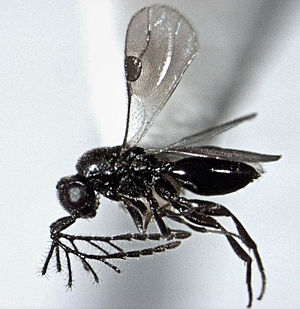Megaspilidae
| Megaspilidae | ||||||||||
|---|---|---|---|---|---|---|---|---|---|---|

Dendrocerus halidayi , male |
||||||||||
| Systematics | ||||||||||
|
||||||||||
| Scientific name | ||||||||||
| Megaspilidae | ||||||||||
| Ashmead , 1893 |
The Megaspilidae are a family of hymenoptera . The well-known 300 species are divided into 12 genera. The family is spread around the world.
features
They are small hymenoptera with a body length of about one to five millimeters. The animals are mostly black in color, often with brown or yellow tones. On the head, the antennae are deflected at the level of the lower edge of the eyes, i.e. relatively deep. They consist of eleven segments in both sexes. The first antenna segment is longer than the others, especially in the females. In the male, the first flagellum segments are often tooth-shaped extended outwards. The pronotum is greatly shortened on the trunk . On the upper side of the middle segment three lines stand out, a central median furrow and two narrow longitudinal keels to the left and right of it, which are called notaulices or parapsids , but these can be shortened or seldom completely absent. The wings have a strongly reduced blood vessels. In the fore wing, this consists of a marginal vein that extends to the large, mostly semicircular wing mark ( pterostigma ); it does not connect directly to this, but is separated from it with a small interruption. A hook-shaped vein of different lengths extends from the wing mark towards the wing tip. There are absolutely no veins in the hind wing. The wings are almost always densely covered by short hairs (microtricha). On the legs, all three pairs of splints ( tibia ) have two spurs at the tip, which are sometimes incised in a comb shape (pectinate). The larger spur of the anterior tibia is two-pointed. The abdomen is usually relatively short and rounded on the sides. It sits on the mesosoma with a short petiolus , and a sculptured collar is often inserted between the petiolus and the rest of the abdomen. The ovipositor of the females is relatively short and hidden in the abdomen when at rest.
Way of life
The larvae of the megaspilids are always parasitoids of other insect species. Very often they parasitize other hymenoptera that are themselves parasitoids ( hyperparasitism ). A large number of species from the most varied of orders have been identified as hosts, including scale insects (Coccoidea), reticulated winged insects ( Neuroptera), winter aphids (Boreidae, order Mecoptera) and dipteras (Diptera). Hosts of the hyperparasitic species are often brackish wasps . The biology of the genus Dendrocerus is best known . Many species of this genus parasitize as hyperparasitoids in species that are themselves parasitoids of aphids or other plant suckers. The parasitoids belong mainly to the (sub) families Encyrtidae and Aphidiinae (Fam. Braconidae). In the last stage, these eat their host to form a hollow shell consisting only of the exoskeleton ("aphid mummy"). At this stage they are covered with an egg by the female of the Megaspilidae through the mummy; the egg-laying takes about 30 to 60 seconds. The hyperparasite eats the brackish wasp larva that is ready to pupate and pupates in the mummy next to its remains. Haviland describes four larval stages. The parasitoid larva feeds on its host from the outside (ectoparasitoid). In addition to aphids, other plant suckers such as scale insects and leaf fleas are primary hosts . Since it also includes economically significant pests, the Dendorcerus species reduce the effectiveness of biological pest control. The infestation rate of the hyperparasite can be quite high and reach over 50%, in exceptional cases up to almost 100% of the host population.
Systematics
The Megaspilidae are one of the two families of the superfamily Ceraphronoidea. Their sister group relationship with the second family Ceraphronidae is well secured by numerous characteristics.
The family is divided into two subfamilies:
-
Megaspilinae . 7 genera
- Genus Megaspilus Westwood, 1829. Holarctic. 2 (possibly 3) types.
- Genus Platyceraphron Kieffer, 1906. Holarctic. 4 types.
- Genus Trichosteresis Förster, 1856. North and South America, Africa, Europe. 2 species.
- Genus Creator Alekseev, 1980. Europe. monotypical, only type creator spissicornis (Hellen, 1966)
- Genus Trassedia Cancemi, 1996. Madagascar. monotypical, unique species Trassedia luapi Cancemi, 1996
- Genus Conostigmus Dahlbom, 1858. worldwide. over 160 species.
- Genus Dendrocerus Ratzeburg, 1852. worldwide. about 100 species.
-
Lagynodinae . Females usually wingless and without ocelles. Pterostigma narrow in winged males. 5 genera.
- Genus Aetholagynodes Dessart, 1994. Australia
- Genus Archisynarsis Szabó, 1973. Europe
- Genus Typhlolagynodes Dessart, 1981. Europe
- Genus Holophleps Kozlov, 1966. Holarctic.
- Genus Lagynodes Förster, 1840. worldwide.
swell
- NDM Fergusson (1980): A revision of the British species of Dendrocerus Ratzeburg (Hymenoptera: Ceraphronoidea) with a review of their biology as aphid hyperparasites. Bulletin of the British Museum (Natural History) Entomology series Vol 41 No 4. 255-313.
- Lubomir Masner (1993): Superfamily Ceraphronoidea. In: H. Goulet & JT Huber (eds): Hymenoptera of the World: An Identification Guide to Families. Research Branch, Agriculture Canada Publication (Ottawa) pp 566-567. ISBN 9993997331
- ↑ Megaspilidae. Hymenoptera online
- ↑ Maud D. Haviland (1920): On the Bionomics and Development of Lygocerus testaceimanus, Kieffer, and Lygocerus cameroni, Kieffer (Proctotrypoidea-Ceraphronidae), parasites of Aphidius (Braconidae). Quarterly Journal of Microscopical Science 2-65, 101-127. download
- ↑ Hajimu Takada (1973): Studies on aphid hyper parasites of Japan. I. aphid hyperparasites of the genus Dendrocerus Ratzeburg occurring in Japan (Hymenoptera: Ceraphronidae). Insecta matsumurana. Series entomology. New series 2: 1-37. download
- ↑ GP Walker & PJ Cameron (1981): The biology of Dendrocerus carpenteri (Hymenoptera: Ceraphronidae), a parasite of Aphidius species, and field observations of Dendrocerus species as hyperparasites of Acyrthosiphon species. New Zealand Journal of Zoology 8 (4): 531-538.
Web links
- GR Broad, L. Livermore: Checklist of British and Irish hymenoptera - ceraphronoidea. In: Biodiversity data journal. Number 2, 2014, p. E1167, doi : 10.3897 / BDJ.2.e1167 , PMID 25197240 , PMC 4152828 (free full text). (With illustrated art gallery)